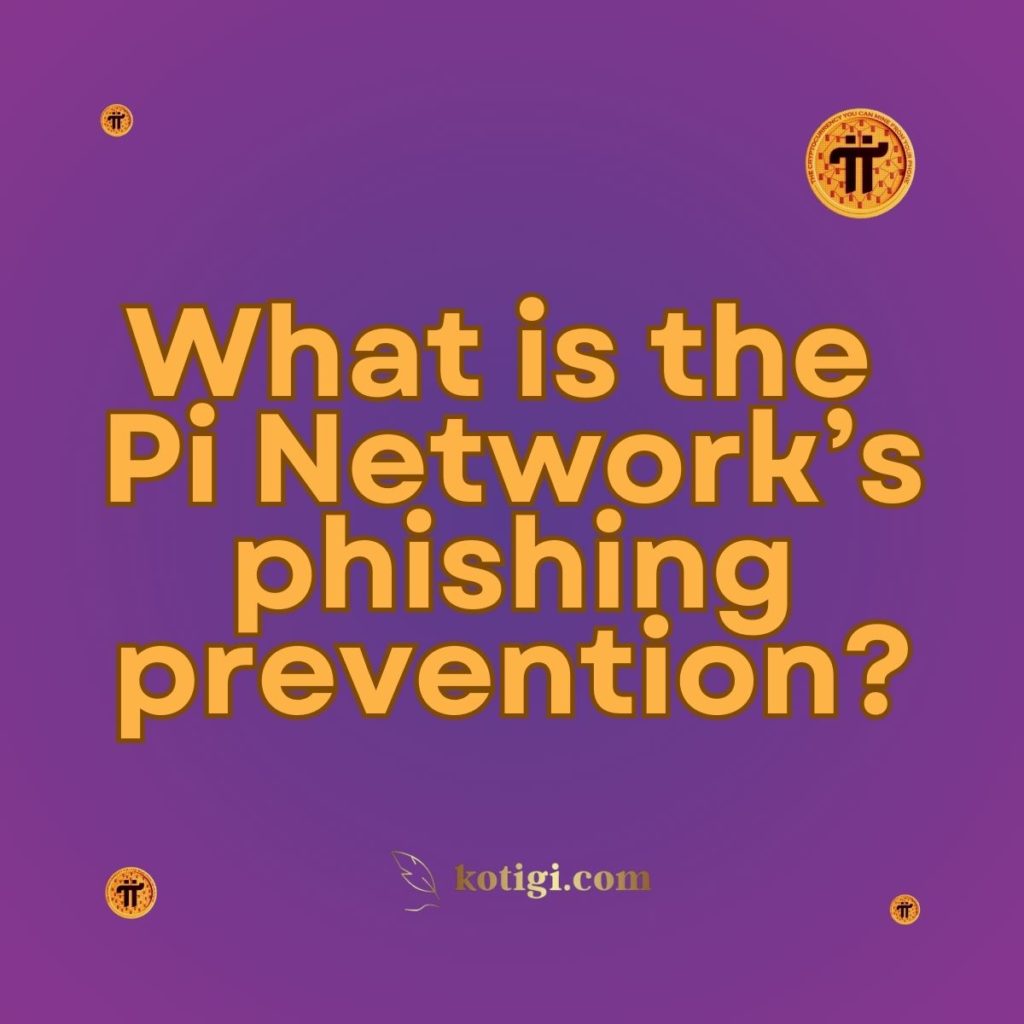
What is the Pi Network’s phishing prevention?
Pi Network implements phishing prevention through a combination of KYC verification, secure communication protocols, user education, and AI-powered monitoring. These strategies help protect users from phishing attempts, ensuring that personal information and account credentials are safeguarded from malicious actors.
Introduction
Phishing is a common online threat where attackers attempt to steal sensitive information, such as passwords, by pretending to be trustworthy entities. In the cryptocurrency space, phishing attacks can be particularly damaging, as they target valuable data like wallet keys and login credentials. Recognizing this threat, Pi Network has built a robust phishing prevention system to protect its users and ensure a secure environment. In this article, we’ll explore how Pi Network combats phishing attempts and safeguards its global community.
Understanding Phishing and Its Impact
What is Phishing?
Phishing is a cybercrime where attackers impersonate legitimate organizations or individuals to trick users into divulging sensitive information. This can happen through emails, fake websites, or messages that appear to be from trusted sources. In the context of Pi Network, phishing attempts might involve fake login pages, deceptive links, or fraudulent messages asking for personal information.
The consequences of falling victim to phishing can be severe. Users may lose access to their Pi accounts or have their personal information exposed, leading to identity theft or financial loss. This makes phishing a critical security concern for Pi Network and its millions of users.
Impact on Cryptocurrency Platforms
Phishing scams are prevalent in the cryptocurrency industry because of the high value of digital assets. Scammers often target users’ private keys or login credentials, which, if compromised, can result in the loss of cryptocurrencies. For Pi Network, which aims to create a secure, decentralized digital economy, preventing phishing attacks is paramount to maintaining user trust and platform security.
Key Strategies for Preventing Phishing on Pi Network
KYC Verification for User Authentication
One of the most effective phishing prevention measures implemented by Pi Network is its Know Your Customer (KYC) process. This system ensures that each user is verified with government-issued identification, making it more difficult for scammers to create fake accounts or impersonate legitimate users. By requiring KYC, Pi Network creates an additional layer of security, as verified users are less likely to fall prey to phishing scams or have their accounts misused.
KYC also discourages scammers from attempting phishing attacks, as the platform’s verification process ensures that accounts are linked to real individuals. This makes it harder for malicious actors to operate anonymously within the network.
Secure Communication Channels
Pi Network strictly enforces the use of secure communication channels to prevent phishing. All official communications take place within the Pi Network app or through verified channels, ensuring that users are interacting with legitimate sources. The platform never requests sensitive information such as passwords or private keys through external platforms, such as email or social media, which helps prevent phishing attempts that rely on fake communication.
Additionally, Pi Network encourages users to verify the authenticity of any communications they receive and warns against interacting with suspicious links or messages outside the app.
AI-Powered Monitoring for Suspicious Activity
Pi Network employs artificial intelligence (AI) to monitor user activity and detect unusual behaviors that may indicate phishing or other forms of fraud. This system analyzes patterns in real-time, looking for signs of phishing attempts such as sudden spikes in login attempts, repeated failed password entries, or the mass sending of suspicious links.
If the AI system detects any potential phishing threats, it can automatically flag the account or block the malicious activity before users are compromised. This proactive approach allows Pi Network to stay ahead of phishing scams and protect its users from potential harm.
User Education and Awareness
Teaching Users to Identify Phishing Attempts
One of the most important components of Pi Network’s phishing prevention strategy is user education. The platform regularly provides updates and resources to help users recognize phishing attempts. These educational materials include guidelines on how to spot phishing emails, identify fake websites, and avoid providing personal information to unverified sources.
By educating users about common phishing tactics, Pi Network empowers its community to be vigilant and cautious. Users are encouraged to scrutinize all external communications and report any suspicious activity to Pi Network’s support team.
Promoting Best Practices for Account Security
Pi Network also promotes best practices for maintaining account security, which helps users protect themselves from phishing attacks. These practices include using strong, unique passwords, enabling two-factor authentication (2FA), and avoiding clicking on suspicious links or attachments. By following these security measures, users can significantly reduce their risk of falling victim to phishing.
Two-Factor Authentication (2FA) for Added Security
Enhancing Login Security with 2FA
To further strengthen its phishing prevention efforts, Pi Network encourages users to enable two-factor authentication (2FA) for their accounts. 2FA adds an extra layer of security by requiring a second form of verification, such as a one-time code sent to the user’s phone, in addition to the standard password.
Even if a scammer manages to obtain a user’s password through phishing, they would still need the second verification factor to gain access to the account. This significantly reduces the chances of a successful phishing attack and ensures that user accounts are protected from unauthorized access.
Role of 2FA in Preventing Phishing Attacks
2FA is particularly effective in preventing phishing attacks because it disrupts the typical flow of a phishing scam. Even if a user unknowingly provides their password to a scammer, the lack of access to the second authentication factor renders the stolen password useless. This added layer of security helps protect against the most common types of phishing attacks.
Preventing Credential Theft and Fake Logins
Securing User Credentials with Encryption
Pi Network secures user credentials using advanced encryption methods. When users log into their accounts, their login credentials are encrypted, making it difficult for hackers or phishing attackers to intercept and steal this information. Even if a user’s credentials are transmitted over a public network, the encryption ensures that the data remains unreadable and secure.
This encryption is a critical part of Pi Network’s scam prevention strategy, as it prevents attackers from using phishing techniques to steal login information. It also ensures that users’ sensitive information is protected at all times.
Fake Login Page Detection
Phishing attackers often create fake login pages to trick users into entering their credentials. To counter this, Pi Network continually monitors for fake websites or login pages that attempt to mimic the official Pi Network app. By identifying and shutting down these fake sites, Pi Network reduces the chances of users being deceived by phishing scams.
Pi Network also advises users to always access their accounts through the official app or website, ensuring that they are not inadvertently logging into a phishing site.
Community Involvement in Phishing Prevention
Reporting Suspicious Activity
Pi Network encourages its global community of users to actively participate in phishing prevention by reporting any suspicious activity or potential scams they encounter. This community-based approach enables the platform to quickly identify and address phishing threats before they can affect more users.
When a phishing attempt is reported, Pi Network’s security team investigates the issue and takes appropriate action, such as warning users, disabling accounts, or blocking malicious links. This decentralized approach ensures that phishing prevention is a collective effort.
Creating a Trusted Environment
By fostering a sense of responsibility and collaboration among its users, Pi Network creates a trusted environment where users feel confident in the platform’s ability to protect them from phishing. This community-driven approach complements the platform’s technical measures, creating a comprehensive phishing prevention system.
Conclusion
Phishing is a serious threat in the cryptocurrency world, but Pi Network has implemented a range of effective measures to combat it. Through KYC verification, AI-powered monitoring, secure communication channels, user education, and 2FA, Pi Network ensures that its users are well-protected from phishing attempts. By prioritizing security and fostering a collaborative community, Pi Network creates a safe environment where users can engage confidently, knowing their accounts and data are secure.
Key Takeaways
- Pi Network uses KYC verification to prevent fake accounts and phishing attempts.
- AI-powered monitoring detects suspicious activities that may indicate phishing scams.
- Secure communication channels and encryption protect users from phishing attacks.
- Two-factor authentication (2FA) provides an additional layer of security against phishing.
- User education and community reporting are key to identifying and preventing phishing threats.





